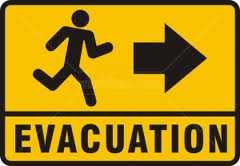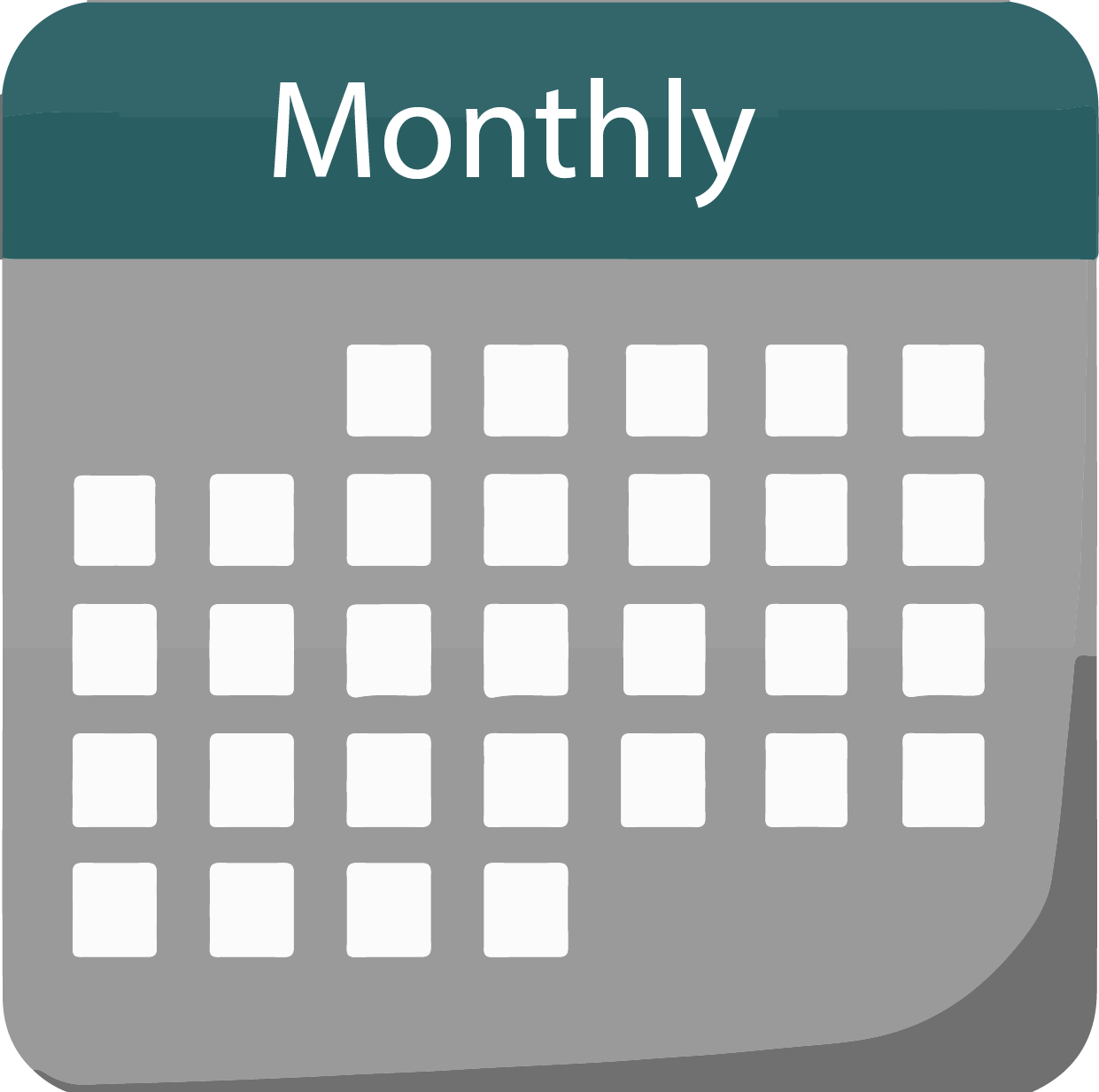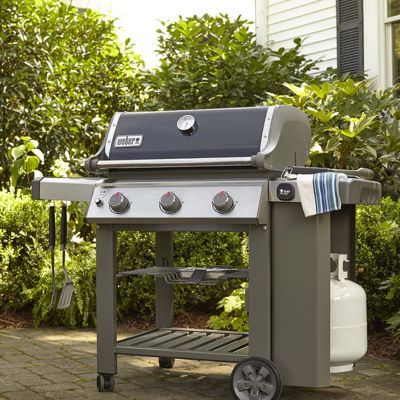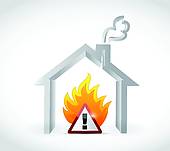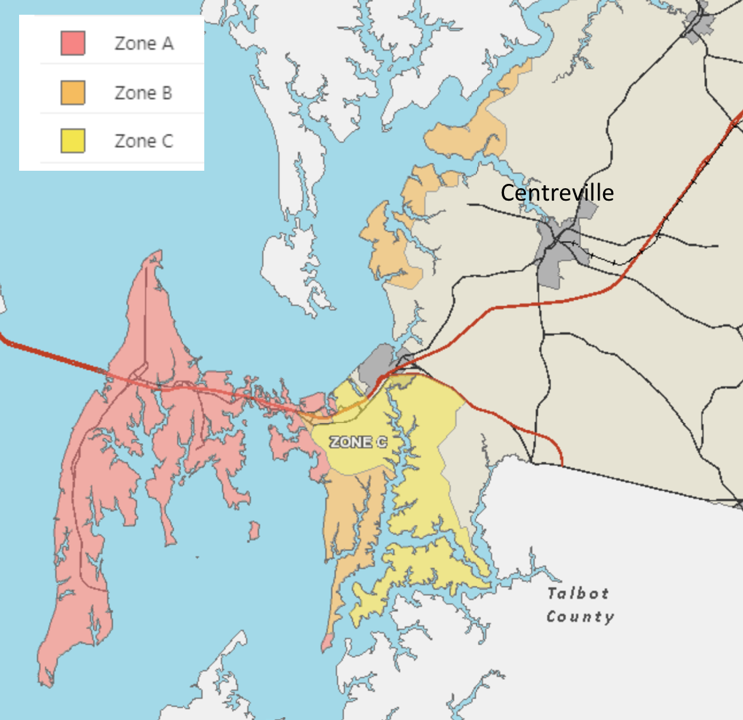Homeowner Information

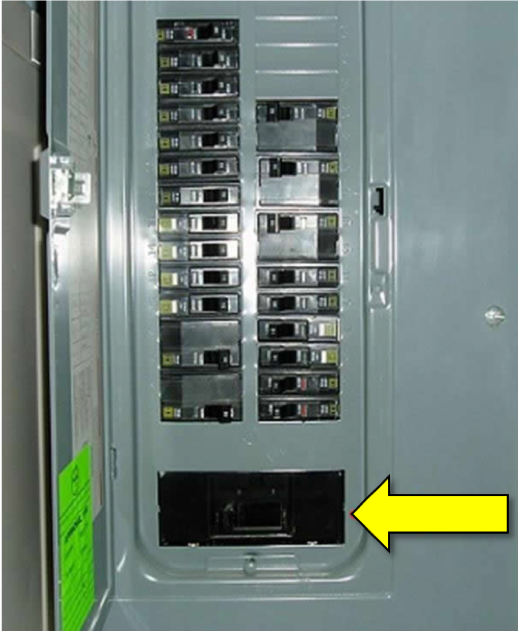 Master shutoff location
Master shutoff location
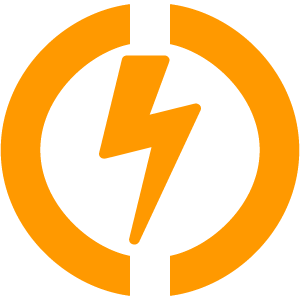 Surprisingly enough, the worst trouble caused by power outages often occurs when the problem is resolved and the power comes back on.
Surprisingly enough, the worst trouble caused by power outages often occurs when the problem is resolved and the power comes back on.
- Prepare for surges: Turn off and unplug all electrical equipment, including your tools, appliances and electronics, and turn your heating thermostat down (or cooling thermostat up) to prevent damage from surges when the power returns. (Major appliances can be turned off at the breaker box.) Leave one light on so you’ll know when the power is restored.
- What not to do: Once the power is restored, don’t turn everything back on at once, which can create internal power surges. First restore the thermostat setting on the heating or cooling system and turn on your larger appliances. Give the electrical system a few minutes to stabilize before plugging in your remaining appliances and electronics.
- Watch for more trouble: If your lights are noticeably dimmer or brighter after the power is restored, turn off all the power at the breaker or fuse box and call your electric utility.
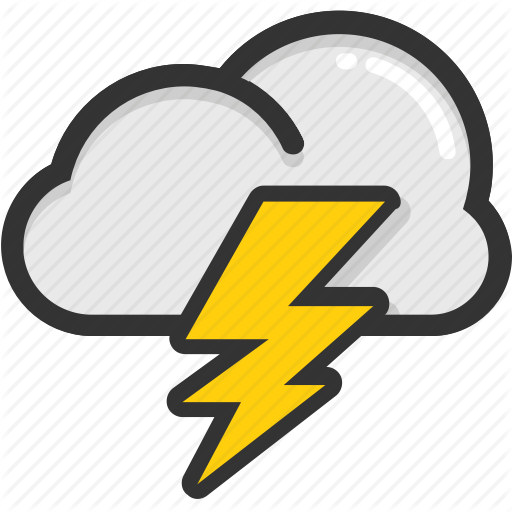 Lightning strikes can burn out circuit boards in appliances, computers and telephones, doing thousands of dollars in damage in less than a second. If you hear thunder, power surges are possible, even if you don’t see any lightning.
Lightning strikes can burn out circuit boards in appliances, computers and telephones, doing thousands of dollars in damage in less than a second. If you hear thunder, power surges are possible, even if you don’t see any lightning.
- Protect your gadgets: Unplug computers and phone lines, and unplug corded telephones and sensitive electronics to prevent damage from power surges.
- Play it safe: Lightning may strike nearby electrical and phone lines and travel to your home. Avoid contact with electrical appliances and telephones (landlines).
- Wacky but true: Lightning strikes can travel through metal plumbing pipes. Avoid sitting on the toilet and don’t shower or bathe during electrical storms.
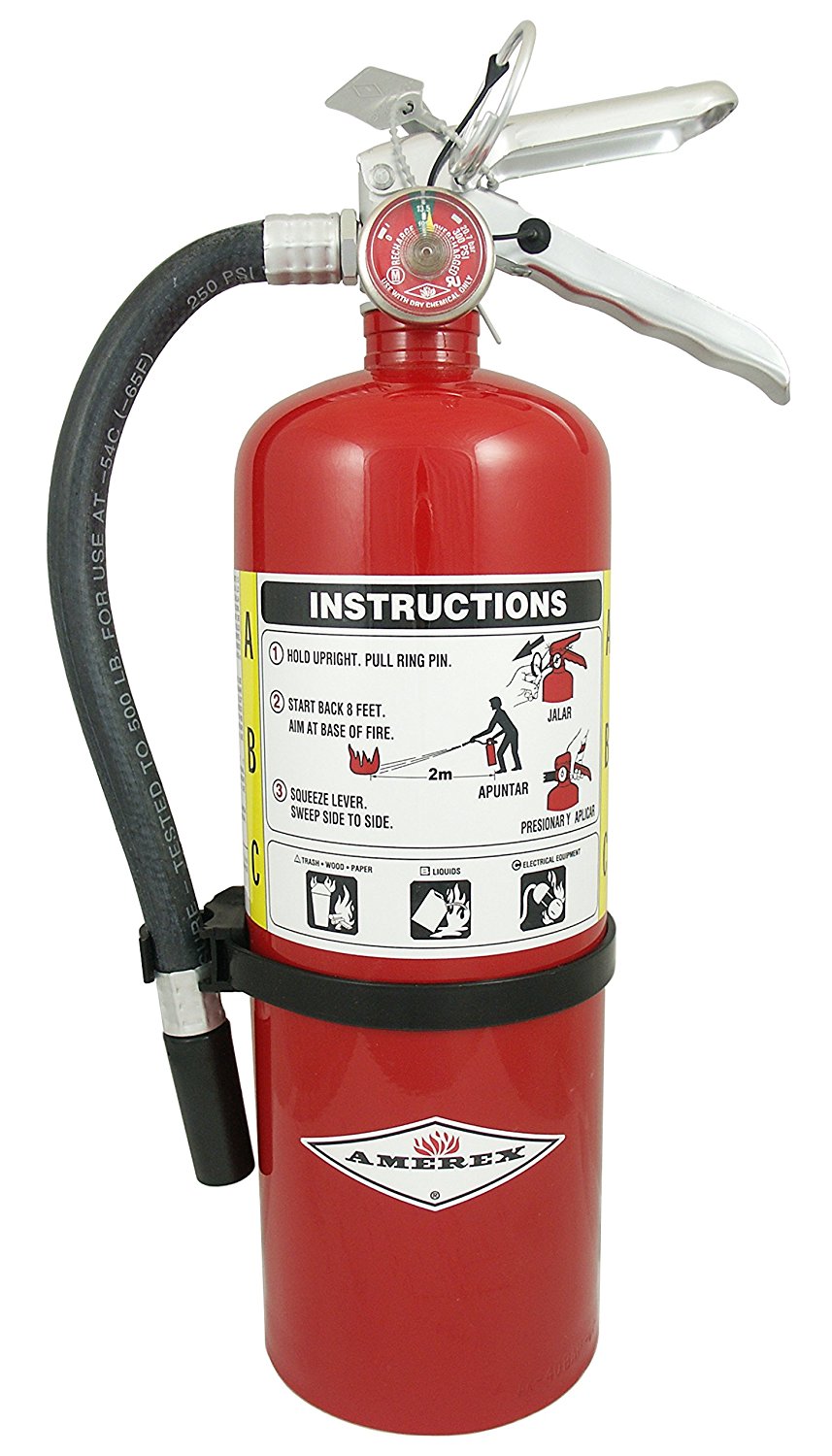 Typical Extinguisher
Typical Extinguisher
To operate a fire extinguisher:
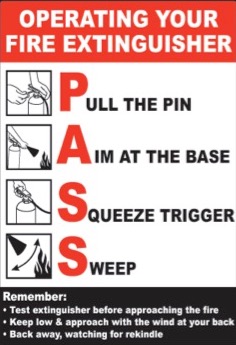
There’s nothing complicated about basic fire extinguisher technique:
|
- Check fire extinguishers to see that the needle points to the green (full) area. If not, replace them or get a recharge if they are rechargeable.
- Periodically turn the extinguishers over and shake them a couple of times to make them ready if you need them.
- Ensure accessibility. Make sure the extinguisher is in its proper spot, visible and easy to access.
- Inspect the seals. Look over the tamper and safety seals to make sure they are intact.
- Check the pressure.
- Look for damage.
- Document your inspection.
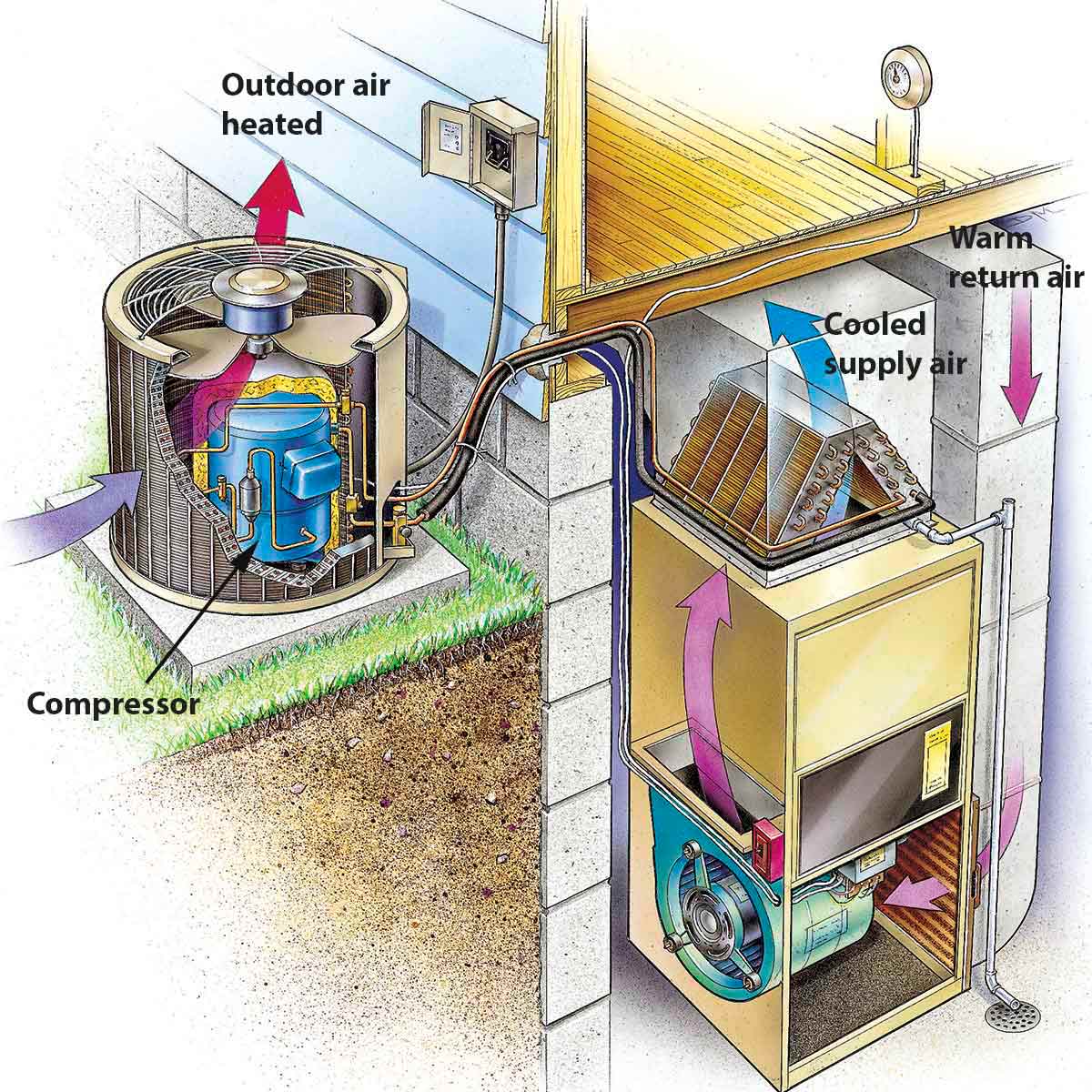
A/C Overview
Click to enlarge Most central air conditioners have two basic parts: an outdoor unit (compressor/condenser) that sits next to your home and an indoor unit (evaporator) that’s located in a central duct near your furnace. If you have a heat pump instead of a furnace, the indoor unit will be in the air handler.
HVAC Contractor. If you are not already on a periodic preventive maintenance program for your A/C or heat pump, contact a HVAC contractor and get on one.
Schedule a yearly preventative maintenance checkup. HVAC systems are complex and should be serviced at least once a year. If your air conditioner or furnace keeps breaking down, it might be time to get a new HVAC system. Most systems last 10 to 14 years if maintained regularly and serviced when needed.
- Keep it Clean: Vacuum the fins of your AC unit clean with a soft-bristle brush. Note: they’re fragile and can easily be bent or crushed. On many units you’ll have to unscrew and lift off a metal box to get at them. Check your owner’s manual for directions and lift off the box carefully to avoid bumping the fins.
- Fix Fins: Realign bent or crushed fins with gentle pressure from a dinner knife. Don’t insert the knife more than 1/2 in.
- Unclog the Condensate Drain Tube: When you see water puddling around the furnace with the AC running, you have a clogged condensate drain tube. Condensation from air conditioning coils contains bacteria that can form slime and clog the condensate pan drain tube.
- Check the air filter. The air filter in your furnace traps dirt, pollen, dust and other particles during both cooling season and heating season. When those particles build up on the surface of the air filter, they slow the flow of air, so the HVAC blower has to work harder. Check the air filter every month and replace it if it’s dirty.
- Check the AC vents. Wipe a pipe cleaner across the louvres that cover the opening to the air conditioner vents in your rooms. Odds are good that you’ll find dust, but if the pipe cleaner also picks up black fuzz, it could be a sign of mold. Have a professional inspect the vents.
- Hear strange noises? Your HVAC system should run pretty quietly. If you hear clanging, banging or other unusual noises, it could be a sign of trouble. Schedule a visit with an HVAC expert.
- Set your thermostat at one temperature. Constant adjusting can cause higher utility costs, especially in the Winter.
- If using your thermostat as a setback type, limit the setbacks to twice a day such as when you are at work and when you are sleeping.
- Only setback the thermostat 6% of desired temperature (approximately five degrees).
- During the heating season, try not to set the thermostat below 65 degrees.
- In the cooling mode, try not to set the thermostat below 70 degrees. Besides higher utility costs, this can cause the indoor coil to freeze and cause condensation in the house.
Get a Programmable Thermostat
 A programmable thermostat is a must-have in today’s state of HVAC technology. Programmable thermostats allow you to set temperatures for various times throughout the day and automatically adjust the temperature when you most need it to help you save money and manage your heating and cooling without constantly hovering over the dial.
A programmable thermostat is a must-have in today’s state of HVAC technology. Programmable thermostats allow you to set temperatures for various times throughout the day and automatically adjust the temperature when you most need it to help you save money and manage your heating and cooling without constantly hovering over the dial.
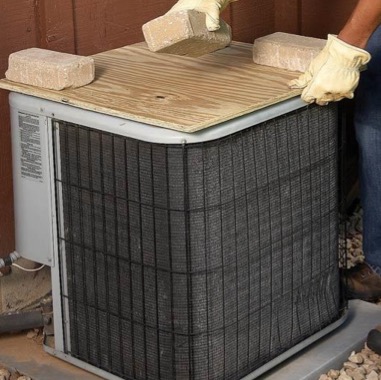
Winter Cover
Many homeowners are tempted to wrap their air conditioner condensers (the outside unit) to protect them over the winter. But wrapping an A/C condenser is never a good idea. Steel rusts, and wet steel rusts even more. Even when wrapped tightly, your condenser isn't airtight. So moisture gets trapped under your tarp and condenses on the inside of the unit. The moisture on your neighbor's condenser is free to evaporate.
Covering an A/C condenser also encourages rodents to move the family into new digs where they're protected from the elements. Once they're settled in, they'll gnaw on the compressor wiring and insulation. Come spring, you'll have a stinky cleanup, a rusty A/C condenser and a hefty bill for rewiring.
If you want to protect the unit from falling icicles, just place a piece of plywood over the fan guard and weight it down with bricks. If you want to protect the metal and keep it looking good, give your condenser a coat of car wax before the snow flies.
- Make it a habit to look at the outdoor unit during the winter months for signs of excessive ice or snow build-up on or around it, especially after bad weather.
- If a heat pump is covered in ice or snow, it must be removed in order to work properly. Turn the thermostat to Emergency heat or the off position and remove the snow and ice. You can pour warm water over the unit to melt the snow and ice. Even cold water from a hose will help, but do not use hot water.
- Do not use any sharp objects to pick or knock the ice off the coils of the unit. This could cause severe damage and personal injury.
- Once the unit is clear of snow and ice turn the thermostat back to normal heating. If the unit ices up again, call for service.
- Do not let the outdoor unit sit underneath a leaking gutter. In the winter months, water will drip on the top of the unit and freeze solid. This will restrict the air flow and cause the whole unit to freeze-up.
- Outdoor units should be elevated 4 to 8 inches above ground level to keep coils clear of snow and ice and to allow for proper drainage.
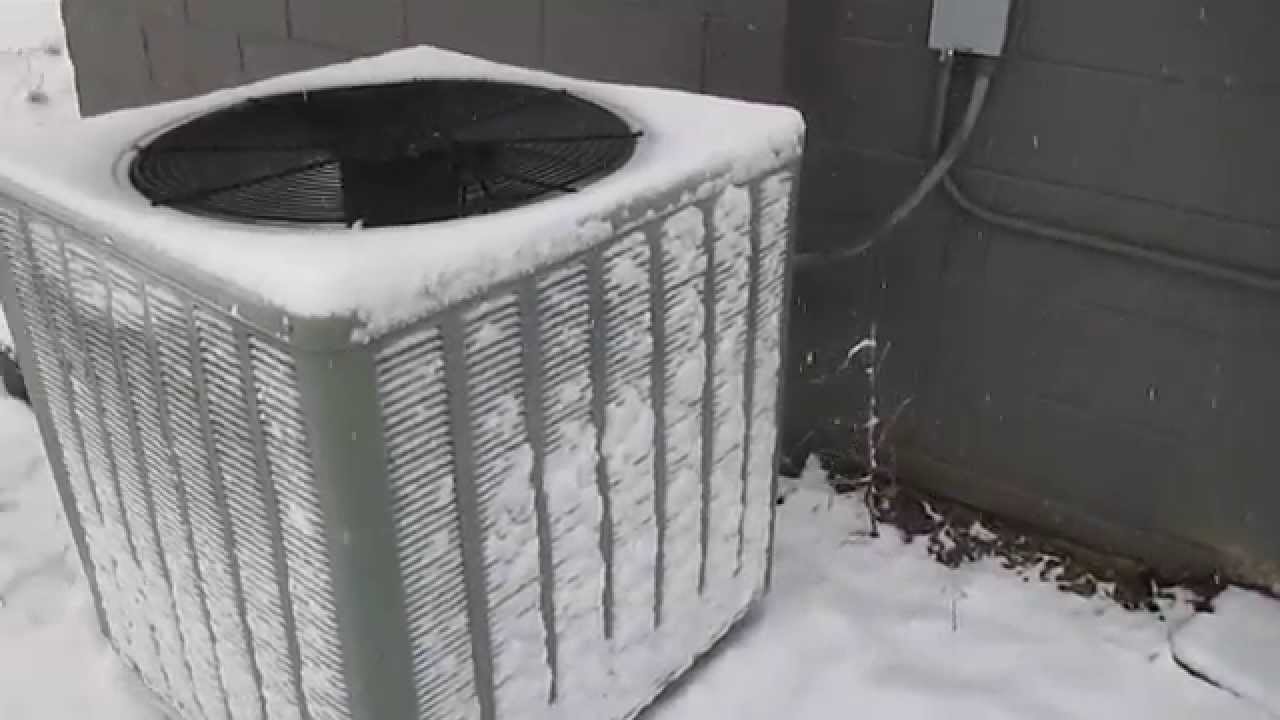
Frozen Outdoor Unit
|
A water heater that has an integrated storage tank is often referred to as simply the “hot water tank”. You can find these in various sizes, though 40 gallon tanks are the most popular. A hot water tank uses either a gas or electric heating element to heat and store water at a set temperature. Most homes in Symphony Village use propane as the fuel for their hot water heater. 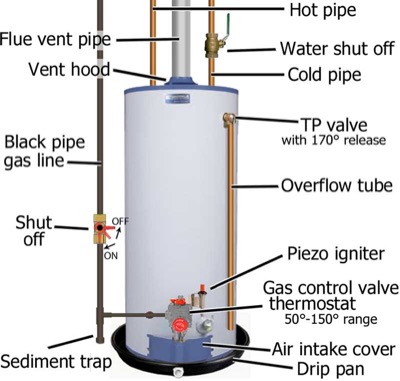 Hot Water Heater Parts |
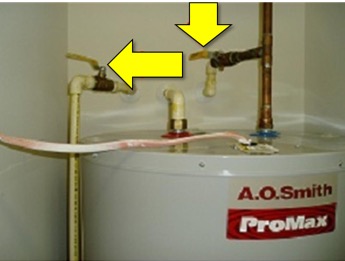
Typical shutoff locations
Once you have located your various shutoffs, tag them so you can easily find them when you need them.
- Control the temperature setting. Set your water heater temperature no higher than 120 degrees for maximum efficiency. Setting it any higher can decrease efficiency and increase the chance of scalding.
- Provide insulation. Wrap your water heater in an insulating blanket that helps enhance performance and decrease standby heat loss.
- Give it space. Be sure to maintain 2 feet of space around your unit. The top of a gas-fired water heater should never be used as a storage shelf.
- Keep it clean. The area around a gas-fired water heater should be vacuumed as needed to prevent dust from interfering with proper flame combustion.
- Take care when on vacation. Use your water heater’s “vacation” setting when you leave town, which maintains the pilot light without heating any water.
- Install a water softener. This helps prevent unnecessary wear and tear on your water heater caused by mineral deposits.
- Maintain the PT valve. Replace the pressure and temperature (PT) valve. on your hot water heater every three years to protect it from extreme pressure and temperature.
- Tune it up. Don’t forget to schedule your annual water heater tune-up. Your plumber should check the pressure relief valve, drain your tank to remove any sediment, if needed, inspect the tank and connections for rust, wear or corrosion, and replace worn anode rods.
PVC valve. Turn the handle one-quarter turn so the handle is across the pipe instead of aligned with the pipe (shown in the off position in the photo),
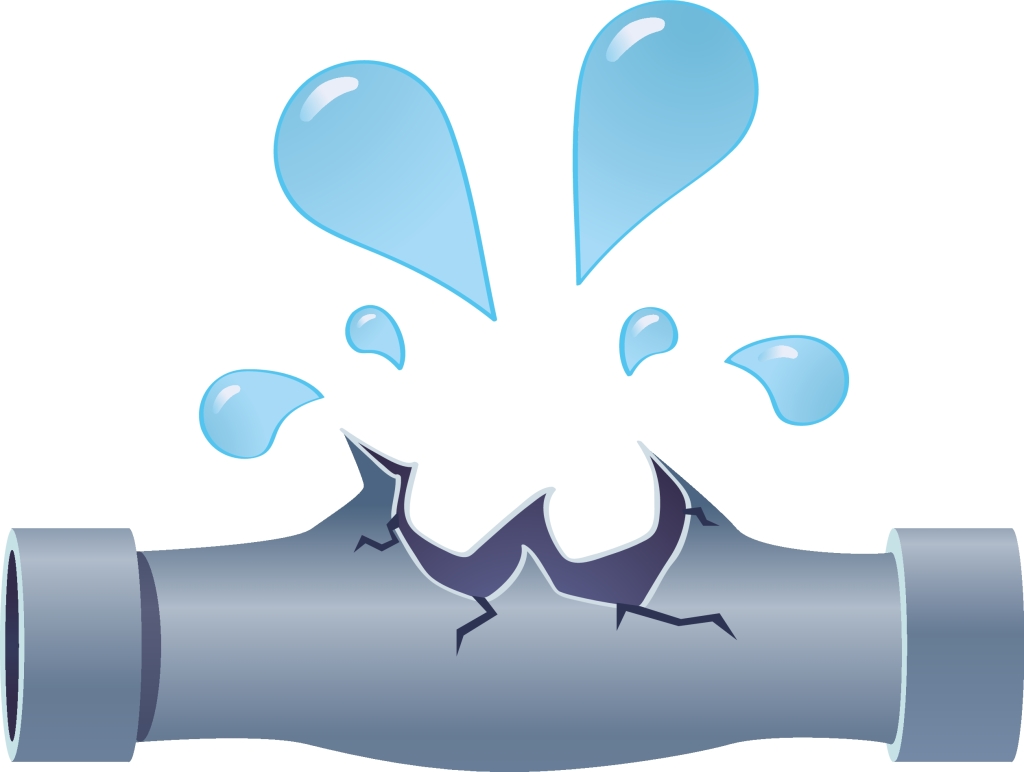 Stop the flow – Shutting off the main water valve is an obvious move. But there may still be a few gallons of water held in pipes above the leak. After the water is shut off, turn on the lowest faucet in the house, which will let the water harmlessly drain out of the faucet instead of through the leaking pipe.
Stop the flow – Shutting off the main water valve is an obvious move. But there may still be a few gallons of water held in pipes above the leak. After the water is shut off, turn on the lowest faucet in the house, which will let the water harmlessly drain out of the faucet instead of through the leaking pipe.
Don’t delay cleanup – The longer things stay wet, the more likely you’ll have permanent damage. Delay can even lead to mold problems inside walls, which can cost thousands to eradicate. So before you run off to buy plumbing parts, clean up the mess.
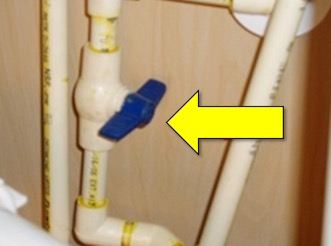 Typical shutoff location |
The shutoff valves are located inside the house, probably under the kitchen sink and under the bathroom sink or in access panels. Close the valve by turning to the right (clockwise). Then go outside and open the faucet to drain out any water in the line.
- Keep your grill at least 10 feet away from your house. If the grill is too close to the house, the heat will warp your siding — or worse, the flames could ignite the siding.
- Always keep the propane canister outside!
- Wear short sleeves or roll them up when cooking on the grill
- Use long-handled barbecue tools
- Keep a three-foot safe zone around grills
- Clean your grill after each use
- Check for gas leaks
- Keep decorations away from your grill
- Keep a spray bottle of water handy
- Keep a fire extinguisher within a couple steps of your grill
- Use a grill indoors or in the garage
- Turn on the gas while your grill lid is closed
- Leave a grill unattended
- Overload your grill with food
| DO NOT store spare propane bottles in the house or garage. If the bottle should leak gas, there is a chance of an explosion from any stray spark. |
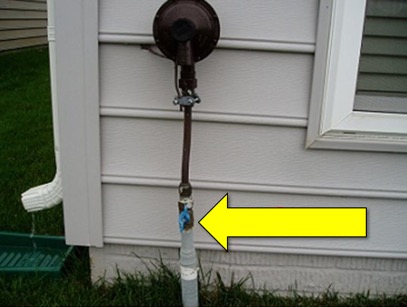 Outdoor shutoff location |
- Do not light matches and immediately extinguish all smoking materials and open flames
- Do not operate electric switches, appliances or flashlights.
- Get everyone out of the area where you suspect the gas is leaking
- Leave doors and windows open, but don't take the time to open them if they are closed.
- Turn off the gas supply valve of your propane tank if it is safe to do so
- Once away from the leak, call 911 and contact your propane supplier. A list of phone numbers can be found here.
- Do not return to the area until your propane retailer, emergency responder, or qualified service technician determines it is safe to do so
- Get your system checked. Before you attempt to use any of your propane appliances, your propane retailer or a qualified service technician must check your entire system to ensure that it is leak-free.
Serious safety hazards, including fire or explosion, can result. If an appliance valve or a gas line is left open when the propane supply runs out, a leak could occur when the system is recharged with propane. Air and moisture could get into an empty or depleted storage tank, which can cause rust build-up inside the tank. Rust can decrease the concentration of the odor of propane, making it harder to smell. If your propane tank runs out of gas, any pilot lights on your appliances will go out. This can be extremely dangerous if not handled properly.
- Always keep flammable and combustible materials (e.g., paper, clothing, wood, gasoline, and solvents) away from any open flames that originate from your appliances.
- Know how to shut off the gas supply from your tank or cylinder. If you do not know how, contact your propane supplier for instructions.
- Never place your head near or directly over the valves on your storage tank. A sudden release of product from the safety relief valve could result in serious injury.
- The propane liquid that is stored in your tank or cylinder can cause severe frostbite if it comes in contact with your skin or eyes.
- Never store propane cylinders or containers inside any enclosed building.
- Treat all propane gas odors seriously. Any odors may indicate a very dangerous situation.
- Never assume that propane odor is only the result of your tank being near empty. If the odor persists, you may have a serious leak.
- You should contact your propane supplier if you suspect a leak.
- Test smoke alarms once a month
- Replace batteries twice a year.
- Never “borrow” a battery from a smoke alarm
- Don’t disable smoke alarms even temporarily
- Regularly vacuuming or dusting your smoke alarm can keep them working properly
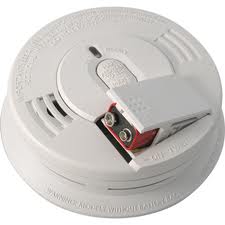
Hint: schedule battery replacements for the same day you change your clocks for daylight savings time
|
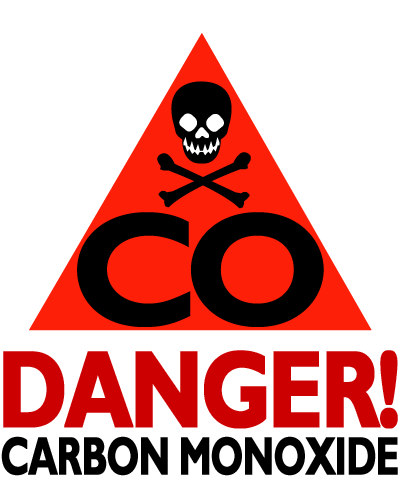 Carbon monoxide (CO) is a colorless, odorless gas that can be deadly. Smoking a cigarette, idling a gasoline engine and burning fuel oil, wood, kerosene, natural gas and propane all produce CO. High levels of CO can be produced when fuels are burned incompletely. Carbon monoxide is the leading cause of accidental poisoning deaths in the United States. Take it seriously and make sure you have working CO detectors in your home.
Carbon monoxide (CO) is a colorless, odorless gas that can be deadly. Smoking a cigarette, idling a gasoline engine and burning fuel oil, wood, kerosene, natural gas and propane all produce CO. High levels of CO can be produced when fuels are burned incompletely. Carbon monoxide is the leading cause of accidental poisoning deaths in the United States. Take it seriously and make sure you have working CO detectors in your home.
Check for symptoms: Symptoms of CO poisoning are "flu-like" and include headache, dizziness, nausea, vomiting and confusion. If the alarm sounds and anyone is expe-riencing any of these symptoms, get everyone out of the house and call 911.
- Don’t assume all is well if no one feels ill.
- Open all windows and doors to let in the fresh air.
- Turn off all potential sources of CO—your oil or gas furnace, gas water heater, gas range and oven, gas dryer, gas or kerosene space heater, and any vehicle or small engine.
- Call your fuel supplier or a licensed heating contractor immediately for an emergency inspection of your fuel-burning appliances and chimneys to make sure they’re operating correctly and that there’s nothing blocking the vents that let fumes out of the house.
- Seek medical attention immediately.
You may take your roof for granted because it is generally out of sight, out of mind. It is the first line of defense, protecting your home from weather damage by acting as the shield that sheds water and protects against snow and ice. As such it is constantly subjected to potential wear and tear that can erode its service life. While most shingle roofs can last anywhere from 15 to 25 years, incremental damage can reduce the lifespan and necessitate an early roof replacement. However a little regular attention can keep them at peak performance. That’s why it is important to keep an eye out for early warning signs with a thorough visual inspection at least once a year.
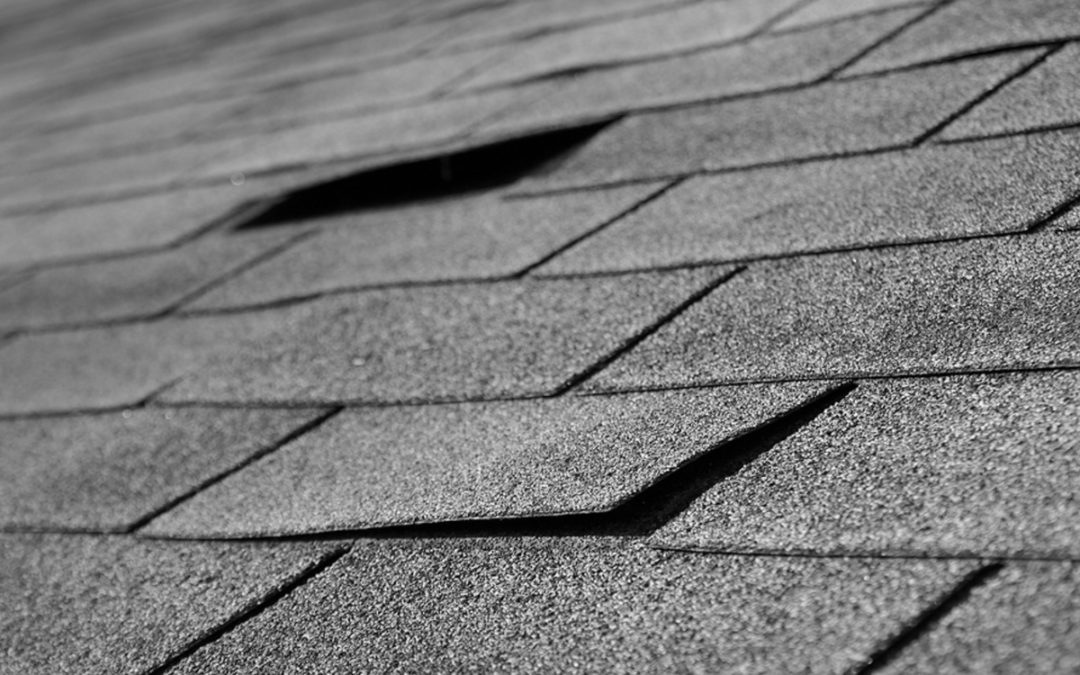 Most homeowners are not comfortable climbing a ladder and getting on the roof and that’s OK. While a professional roofer will certainly take this approach, a homeowner can do a thorough inspection from the ground with a pair of binoculars.
Most homeowners are not comfortable climbing a ladder and getting on the roof and that’s OK. While a professional roofer will certainly take this approach, a homeowner can do a thorough inspection from the ground with a pair of binoculars.
Once you are ready to inspect your roof you will need to know what to look for. Damage can occur from wind, hail, water and falling objects like tree limbs so there are a variety of ways damage can present itself. The sections on indoor and outdoor inspection provide some of the clear signs that your roof may need attention.
- Look for leaks – One of the most telling signs of trouble with your roof is leaks inside the house. Consistent leaks after rain are obvious but you should also pay close attention after severe weather. The combination of high wind and rain can often stress a roof at its weakest points and reveal early signs that areas need attention. Look specifically in areas where dormers, chimneys or other obstructions create potential leaks.
- Look for granules in gutter and downspouts – Asphalt shingles have a top coating of granules that protect the softer surfaces from UV radiation. It is normal for some of these granules to end up in gutters and downspouts so the mere sight of them is not cause for alarm. However, if you notice a sudden increase of granules it is a sign that shingles may be approaching the end of their service life. Without a consistent coating of granules, shingles are vulnerable to UV radiation that will make them brittle and susceptible to damage.
- Visible shingle damage – Inspect the shingles and look for cracked, cupped, or missing shingles.
- Broken or Missing Shingles – Shingles that have become brittle will crack when subjected to heavy winds and eventually may break off completely. While overlapped shingle courses will prevent immediate leaks from missing shingles, it is a clear sign that there is an issue.
- Cupped Shingles – Also look for cupped shingles. Cupping often occurs when an attic is not vented properly and overheats the underside of the shingle causing the edge to curl or cup.
- Flapping shingle – If you get the opportunity, look at your roof on a very windy day. If you see shingles lifting or flapping in the wind, the sealant strip under the shingles may have been damaged. This can allow water into the system where it can do damage.
- Damage to Flashing – Flashing protects transition areas in your roof where shingles meet siding. Missing or damaged flashing will allow moisture under the shingles and begin to cause damage to the roof system and the structure itself.
If your roof passes these inspection points then you are probably in pretty good shape, but if one or more of these trouble spots appear it may be time to call a professional. While an inspection by a homeowner can catch some obvious signs, a professional roof inspection will provide a clear picture of what’s happening and also provide information about roof repair and roof replacement options.
 If a water pipe in your home or yard breaks, would you know how to shut off the water to avoid flooding?
If a water pipe in your home or yard breaks, would you know how to shut off the water to avoid flooding?
Find out where your water meter and shut-off valve are located before there’s an emergency.
- Your inside water main valve fails and you have a water emergency (burst pipe)
- You have a leak or burst pipe before the main inside valve (between the street and the inside valve)

Water Shutoff Valve
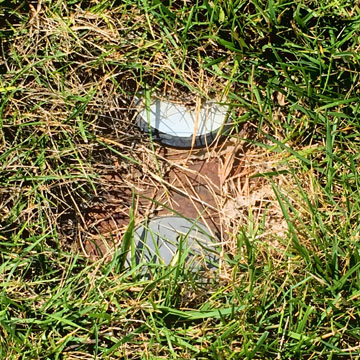
Overgrown
Meter Cover
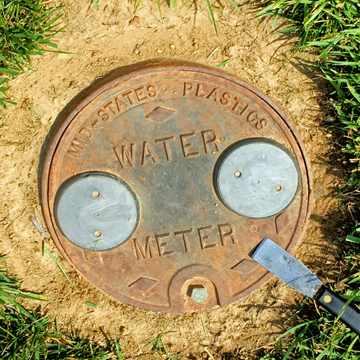
Cleared
Meter Cover
Fill out the form in pencil, slip it into the provided sleeve, and attach it to the refrigerator. The file contains your name, address, doctors, emergency contacts, medical data, pertinent personal data, medical conditions (checklist), allergies (checklist), and your insurance information. Then, update it when you have changes and/or review it each six months for updates. It's a no brainer!
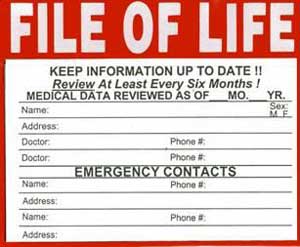
Click on the form for a printable copy |
To help us as first responders, we ask that you voluntarily complete this CONFIDENTIAL Emergency Information Form and return it to the SV Management Office. The form is available from the clubhouse, by clicking the picture at the right.
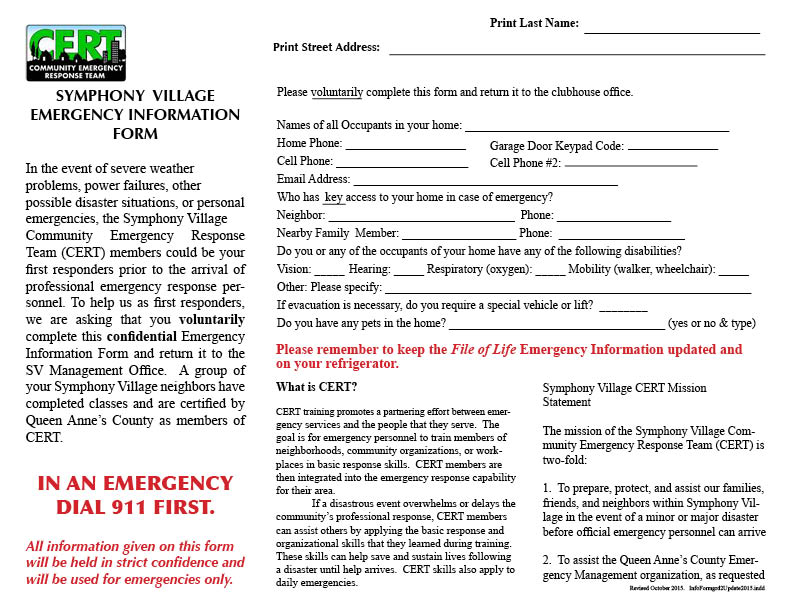 Click on the form for a printable copy |
| The form contains information about who the occupants of the house are, who has key access to the house, if anyone has any disabilities, and other information that might be useful to first responders in an emergency. |
- Cooking
- Smoking
- Electrical & Appliance Safety
- Portable Space Heaters
- Gas Fireplaces
- Stay in the kitchen when you are frying, grilling, or broiling food. If you leave the kitchen for even a short period of time, turn off the stove.
- Wear short, close-fitting or tightly rolled sleeves when cooking.
- Keep children away from cooking areas by enforcing a"kid-free zone" of 3 feet around the stove.
- Position barbecue grills at least 10 feet away from siding and deck railings, and out from under eaves and overhanging branches.
- If smoking outside, completely stub out butts in an ashtray or a can filled with sand.
- Soak cigarette butts and ashes in water before throwing them away. Never toss hot cigarette butts or ashes in the trash can.
- Never smoke in a home where oxygen is used, even if it is turned off. Oxygen can be explosive and makes fire burn hotter and faster.
- Be alert – don’t smoke in bed! If you are sleepy, have been drinking, or have taken medicine that makes you drowsy, put your cigarette out first.
- Frayed wires can cause fires. Replace all worn, old or damaged appliance cords immediately and do not run cords under rugs or furniture.
- If an appliance has a three-prong plug, use it only in a three-slot outlet. Never force it to fit into a two-slot outlet or extension cord.
- Immediately shut off, then professionally replace, light switches that are hot to the touch and lights that flicker.
- Keep combustible objects at least three feet away from portable heating devices.
- Buy only heaters evaluated by a nationally recognized laboratory, such as Underwriters Laboratories (UL).
- Check to make the portable heater has a thermostat control mechanism, and will switch off automatically if the heater falls over.
- Clean and adjust the logs and accessories like the glowing “embers” so they look their best.
- Clean the fan and air circulation passages.
- Clean the glass.
- Check the batteries in the carbon monoxide detector.
- Make sure vents are unobstructed.
- Never use stove range or oven to heat your home.
- Keep combustible and flammable liquids away from heat sources.

- Put together a Family Emergency Communications Plan
- Complete the SV Emergency Information Form and take it to the SV Clubhouse management.
- Put together an emergency supply kit for your home.
- Know the nearest police and fire stations.
- Learn your community’s warning signals and what to do when you hear them.
- Keep a small amount of cash available. If power is out, ATM's won't work.
- Learn first aid, CPR, and use of the AED.
- Have a first aid kit and extra medicine.
Here are some websites with additional resources for homeowners.
- ADT Safety & Security Tips
- Home Safety Tips – A Comprehensive Resource: Atlantic Training Guide to Home Safety
- Product Recalls: from the Consumer Product Safety Commission
- Home Safety Tips from Family Handyman: Tips to help you keep your family safe during storms, prevent home fires and more.
- 50 Best Tips to Make Your House Super Clean: Good Housekeeping Cleaning Tips
- Find Trusted Home Improvement Pros: HomeAdvisor makes it easy to find local pros who specialize in exactly the type of work you need done.
- Hometime: is one of the longest-running home improvement programs on television.
- Smoke detectors & carbon monoxide detectors; test & check batteries
- Installed alarm systems or devices & test operating condition.
- Check flashlights & batteries where you have placed for emergencies; have back‐up batteries
- Replace or clean all filters where needed in heat/air unit, at return vents, room air conditioner, air purifier machines, etc.
- Hot water heater sediment removal by draining 2 gallons of water or have professional check
- Replace carbon cartridge of water filter
- Inspect fire extinguishers for proper working condition & check gauge for charge.
- Check fireplace monthly when using for creosol buildup.
- Clean & check for damage on stovepipe if you have one on your chimney.
- Inspect & clean pads or plates in humidifier or have professional inspect.
- Check breaker box monthly or have a professional, especially if breakers trip often.
- Clean smoke detectors. Remove cover, remove battery, vacuum & clean cover. Replace cover & test.
- Clean hot water heater. Drain tank, clean heating elements with vinegar & water solution. Turn power off before cleaning.
- Have professional lubricate heater blower fan & motor.
- Inspect & clean outside heat/air unit of all leaves, limbs or other debris. Clean outdoor dryer vent opening of all debris.
- Clean gas &/or electric space heaters by a professional or be trained.
- Clean entire room air conditioning unit inside & outside as needed.
- Check for erosion in the yard & the driveway or walkways for cracks or needed repairs.
- Inspect roof, shingles, chimney & flashing around gutters & downspouts, vent stalks & roof edges.
- Check inside the home at joints on floor or wall for needed repairs such as on ceramic tiles, linoleum, hardwood floor for any replacement or any water damage or cracks.
- Check for needed insulation in bathrooms on tile & insulation on doors or windows.
- Clean gas heater–shut off first then clean the exhaust vent, shutter openings & burner.
- If you have an attic fan you should have it inspected by a professional before using for the summer or hotter time of year. Clean in attic & around fan.
- Close shut off valves to outside faucets & waterlines & be sure to drain.
- Clean & check for proper operation of all gutters & downspouts. Paint if needed & replace any rusted parts.
- Refill water softener with salts
- Test operation of hot water tank.
- Check wood interior and exterior for signs of termite damage or hire a termite company to check on annual basis.
- Inspect all windows & doors for gaps, cracks or other damage & seal with proper insulation such as caulk or weather stripping. Repair any broken glass as needed.
- Check roof for any needed repairs such as shingles, flashing, chimney or gutters & downspouts.
- Check vents & louvers for free moving air.
- Check brick for any cracks or foundation settling signs.
- Check for any water damage or accumulation of water on the home from drains; check faucets, hoses, bibs, commodes & shutoff valves for leaks.
- Inspect basement or crawl space for any signs of water damage, excess moisture or mold.
- Insulate all pipes & water lines to prevent freezing.
- Insulate attic & basement where needed to keep heating cost down.
- Have heating unit and space heaters inspected prior to use for safety, cleaning & proper operation.
- Cover outdoor air conditioners & attic fan prior to winter.
- Clean humidifier if you have one connected to your heating unit.
- Check flame color on gas furnace for blue color NOT yellow.
- Inspect & clean for safety the fireplace or other heating source and repair as needed.
- Close shutoff valve to outside faucets & water lines.
- Remove all leaves from home exterior heat/air units & at gutters & downspouts. Repair gutters & downspouts as needed.
- Refill water softener with salts
- Test hot water tank.
- Clean smoke alarms
- Clean electric water heater by draining.
- Have any heating source inspected by a professional.
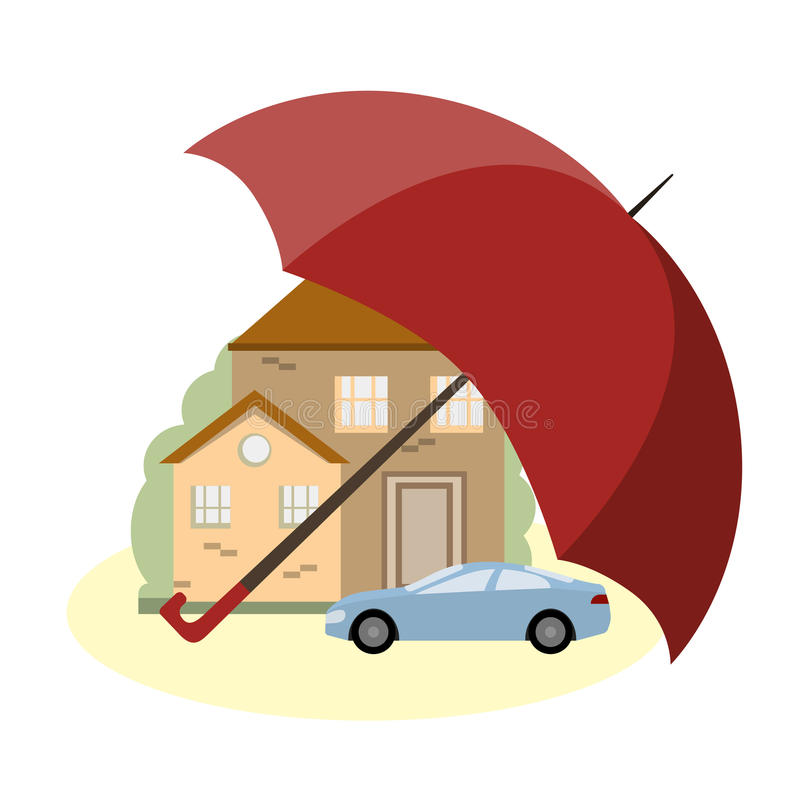
The best thing you can do is to prepare ahead of time.
|
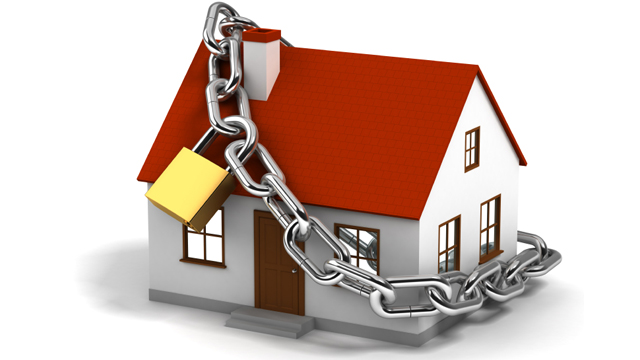
Click for Home Security Checklist
- Consider a monitored alarm system with alarm devices on doors, windows or other areas where intruders might try to enter. Set alarms when leaving, at night, & during the day if needed to stay safe.
- Display alarm signs (even if you don't have an alarm system) that may deter criminals from your home.
- You may consider video systems around your home & property.
- Adequate outdoor lighting that uses motion sensors will help deter theft.
- Be cautious of strangers or unplanned visitors in the area. A badge is not enough to trust a stranger at your door.
- Lock away all firearms from children & separate ammunition as needed. Use safety locks for firearms.
- Use fireproof & waterproof safes to store dangerous items such as firearms & to store important documents & personal items.
- Use bolt locks on doors & inside keyed locks where there is glass near the locks that could be broken for access to the lock.
- Use caution if leaving a spare key outside your home. Store extra keys with family members or trusted neighbors.
- Do not leave valuables in cars especially if not in the garage. Never leave a garage door opener in a car parked outside the garage.

While the Internet brings many conveniences, it also comes with risks. Cybercriminals use sophisticated techniques to appear legitimate; they pose as:
- Friends or family members
- Banks
- Charities
- Mortgage vendors
- Healthcare and low-cost prescription providers
- Create passwords and make them strong. If you do not use the password feature on your internet-enabled devices, you leave them open to whomever may pick them up. Lock all of your devices including computer, tablet and smartphone with secure passwords. That will keep prying eyes out and add a line of defense in case your devices are lost or stolen. A strong password is at least 12 characters long. Strong password tips include the use a mix of letters, numbers and symbols, and try not to include personal information.
- Secure access to your accounts. Since passwords can be stolen, adding two-step authentication to accounts provides a second layer of protection. Many online services, including apps and websites, offer free options that could help you protect your information and ensure it’s actually you trying to access your account – not just someone with your password. Learn to “Lock Down Your Login” at www.lockdownyourlogin.com. And, for more information about two-step authentication, go to www.turnon2fa.com.
- Secure access to your devices. Keep your mobile devices in your possession at all times and always be aware of your surroundings.
- Think before you act. Emails and communications that create a sense of urgency such as a problem with your bank account or taxes is likely a scam. Consider reaching out directly to the company by phone to determine if the email is legitimate or not.
- Most businesses or organizations don’t ask for your personal information over email. Beware of any requests to update or confirm your personal information.
- Avoid opening attachments, clicking on links, or responding to email messages from unknown senders or companies that ask for your personal information.
- Beware of “free” gifts or prizes. If something is too good to be true, then it probably is.
- When in doubt, throw it out. Clicking on links in emails is often how scammers get access to personal information. If an email looks unusual, even if you know the person who sent it, it’s best to delete it. Remember that scammers can commandeer friends’ email addresses and send you messages posing as them. Turn on spam filters for your email account to help filter suspicious messages.
- Share with care. Be aware of what you share publicly on social media sites like Facebook. Adjust your privacy settings to limit who can see your information. Avoid sharing your location. It is important to add only people you know on social media sites and programs like Skype; adding strangers could expose you and your personal information to scammers.
- Use security software. Install security software on your devices from a reliable source and keep it updated. It is best to run the anti-virus and anti-spyware software regularly. Be wary of security updates from pop-up ads or emails. They may actually be malware that could infect your computer.
- Adjust your browser safety settings. You likely search for news, information and products by using an internet browser such as Firefox, Google Chrome, Internet Explorer and Safari. Adjust your settings in each of those browsers to set your options for optimum security. Those menus can often be found in the upper right corner of your browser. Consider clearing your browsing history at the end of your session so you don’t leave a trail of sensitive data.
- Use the default firewall security protection on your computer. Your operating system (OS) likely has default firewall settings that will protect your computer without needing adjustment. If your antivirus software includes additional firewall protection that you can adjust separately, consider contacting a computer professional for assistance to ensure you’re safely protected without over-blocking sites and programs you use regularly.
- Log out. Remember to log out of apps and websites when you are done using them. Leaving them open on your computer screen could make you vulnerable to security and privacy risks.
- Consider support. If you live alone or spend a lot of time by yourself, consider a trusted source to serve as a second set of eyes and ears. Adult family members and grandchildren who are computer savvy may be willing to help.
- Be sure to find out who is providing the information, know where you’re going online.
- Many pharmaceutical companies create websites with information to sell products.
- Look for sites ending in .edu (for education) or .gov (for government).
- Avoid accessing your personal or bank accounts from a public computer or kiosk, such as the public library.
- Don’t reveal personally identifiable information such as your bank account number, social security number or date of birth to unknown sources.
- When paying a bill online or making an online donation, be sure that you type the website URL into your browser instead of clicking on a link or cutting and pasting it from the email.
- Make sure the website address starts with “https,” s stands for secure.
- Look for the padlock icon at the bottom of your browser, which indicates that the site uses encryption.
- Type new website URLs directly into the address bar instead of clicking on links or cutting and pasting from the email.

Consumer Guide for Marylanders (scams, tips, resources)
Click to open
While the Internet allows us to stay connected, informed, and involved with family and friends, any public environment requires awareness and caution. Just as you use locks to keep criminals out of your home, you also need safeguards to secure your computer. Below find resources and materials to help you stay cyber safe.
- Protect yourself, your family, and your devices with tips and resources from the National Cyber Security Alliance.
- Learn about the common fraud schemes aimed at older Americans from the Federal Bureau of Investigation (FBI).
- Avoid scams, protect your identity, and secure your computer with tips from the Federal Trade Commission’s (FTC) OnGuard Online.
- File a complaint with the Internet Crime Complaint Center or your State Attorney General's Office if you are a victim of online crime.
- Follow ten simple, customized steps from the Federal Communications Commission’s Smartphone Security Checker to secure your mobile phone. In addition, learn how to safely use public Wi-Fi networks and what steps to take if your phone is stolen.
| The following resources from government agencies, universities, and other trusted organizations provide tips on how to stay safe at home as a senior. |

|
|
Contents
– Safety Tips – Fall, Fire, & Accident Prevention – Home Safety Products – Food Safety – Home Safety – Home Safety Blogs & Articles |
- Must-Know Safety Tips for Senior Citizens: Nationwide Insurance offers these safety tips for avoiding falls and other accidents.
- 12 Summer Safety Tips for the Elderly: Summertime and its high temperatures can be hazardous for seniors. This article explains how you can take steps to stay safe.
- Aging in Place: Senior Home Safety Tips: Find general home safety tips, bathroom safety, and living space safety in this resource.
- 50 Safety Tips for Seniors: Parent Giving shares a comprehensive list of the most important safety tips that seniors should follow in and out of their homes.
- Cold Weather Safety Tips for Seniors: Follow these tips to stay warm and safe during the cold winter season.
- Home Safety Tips for Seniors: Seniors can learn more about how to stay safe at home with these tips and a handy checklist.
- Seniors and Kitchen Safety: Tips for the Home: Comfort Keepers points out the danger of cooking at home for seniors, and encourages caregivers and the elderly to consider these tips for identifying potential hazards.
 Falls are among the most common accidents at home for seniors, and elderly adults are especially at risk of death due to house fires. Use these resources to find out how you can take steps to prevent these tragedies.
Falls are among the most common accidents at home for seniors, and elderly adults are especially at risk of death due to house fires. Use these resources to find out how you can take steps to prevent these tragedies.
- Older Adult Falls: This resource from the CDC shares how dangerous older adult falls can be and proven ways to reduce falls.
- Home SAFE: Find resources for fall prevention, home modification, fire protection, and healthy home strategies from Home SAFE.
- 5 Fall Safety Precautions for the Elderly: Griswold Home Care shares give important safety precautions the elderly should take to avoid falling.
- Home Safety for the Elderly: Miami Dade's guide to home safety for the elderly focuses on falls, fire, and other hazards.
- Fire Safety Outreach Materials for Older Adults: Discover senior fire safety statistics, a fire safety checklist, tips, fire escape planning, and more in this resource from the U.S. Fire Administration.
- Slip, Trip, and Fall Protection for Older Adults: The National Safety Council's resource shares information on preventing falls, slips, and trips in the elderly population.
- Fire Safety for Seniors: FDNY's guide to fire safety for seniors is full of helpful tips for preventing specific fires, fire escape planning, smoke alarm maintenance, and a handy fire safety checklist.
- Home Safety Assessment: Maryland Health Care Commission's Home Safety Assessment offers a home safety checklist, housing safety checklist, safety improvements for your home, and more.
- How Medical Equipment Can Ease Daily Living of Senior Citizens: Concordia Lutheran Ministries shares suggestions for useful aides that ease daily living for seniors.
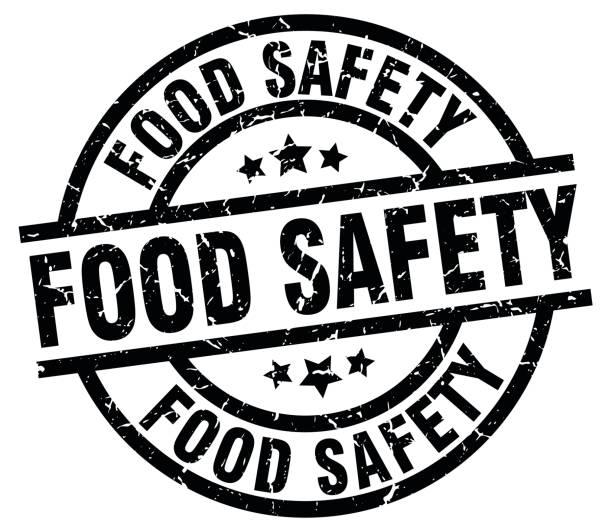 Another home safety concern for seniors: food. Elderly adults are more susceptible to illness from food borne illnesses. These resources explain how seniors can eat, safety, and store food safely.
Another home safety concern for seniors: food. Elderly adults are more susceptible to illness from food borne illnesses. These resources explain how seniors can eat, safety, and store food safely.
- Food Safety for Older Adults: Follow these guidelines to make sure the food you're eating is safe and healthy.
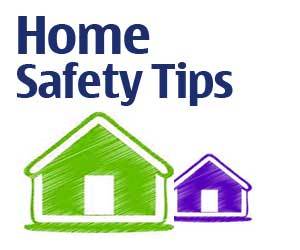 Use these resources for assessments and checklists to find out if you have any items that need attention in your home.
Use these resources for assessments and checklists to find out if you have any items that need attention in your home.
- Consumer Product Safety Commission Safety for Older Consumers Home Safety Checklist: The CPSC's checklist for senior home safety helps elderly to prepare for emergencies and identify possible safety problems.
- Home Safety for the Elderly: This guide from the International Association of Certified Home Inspectors focuses on specific areas of the home where it's important to inspect for safety hazards.
- Home Safety: How Well Does Your Home Meet Your Needs?: AARP's caregiving checklist assesses the safety of walkways, appliances, electrical, and more.
- Age in Place: Age in Place is an excellent resource for senior safety, offering articles and more explaining how the elderly can manage safety hazards and more.
- Safety for Seniors at Home: Find out how you can make your home senior safe with home security, fire safety, gas and electric safety, and more.
- Senior Home Safety Blog: Follow this blog for senior home safety information and news on senior home care safety initiatives.
